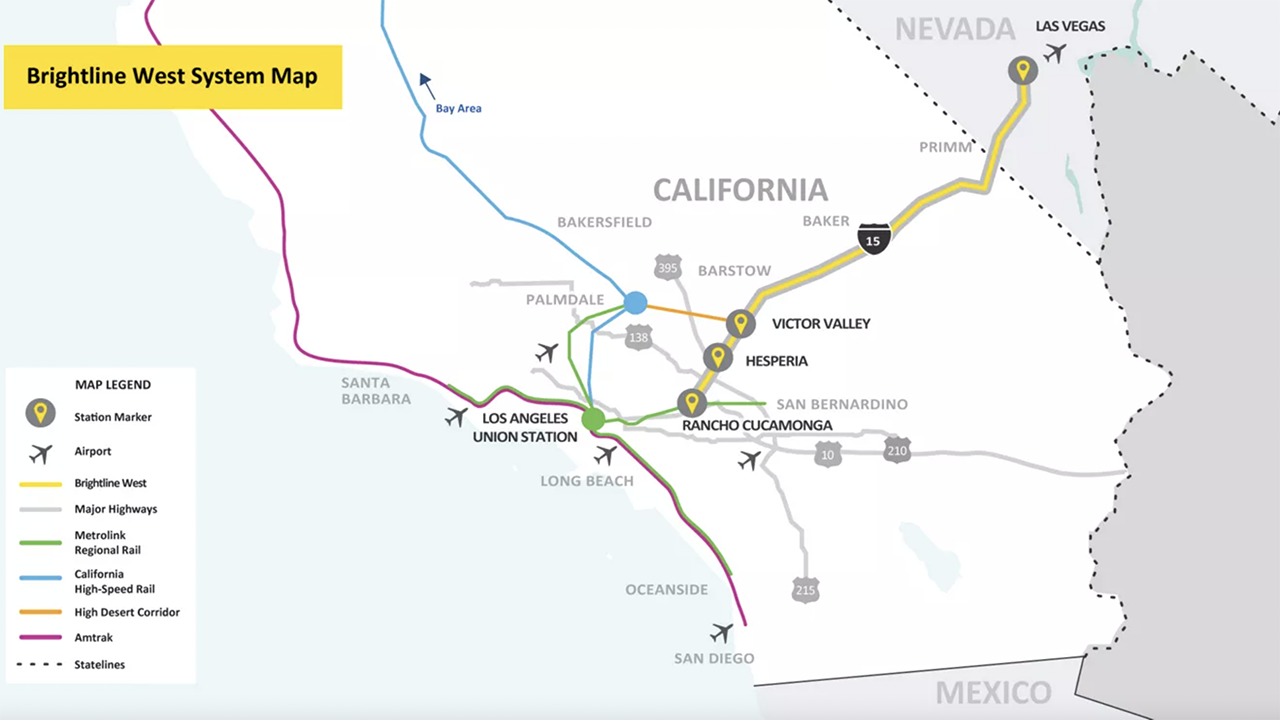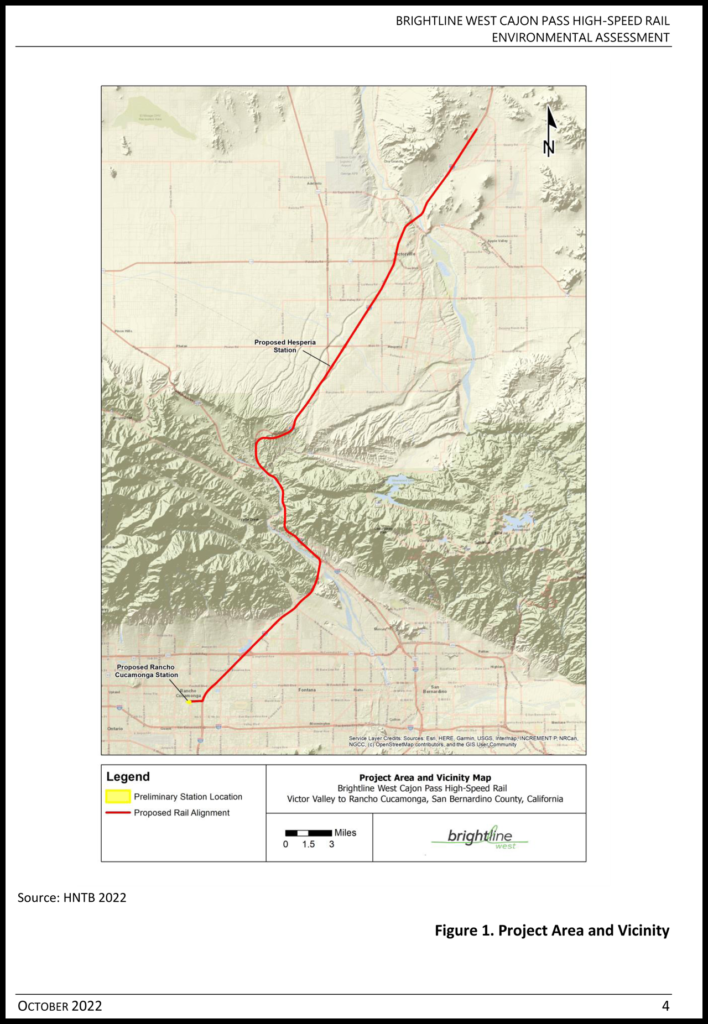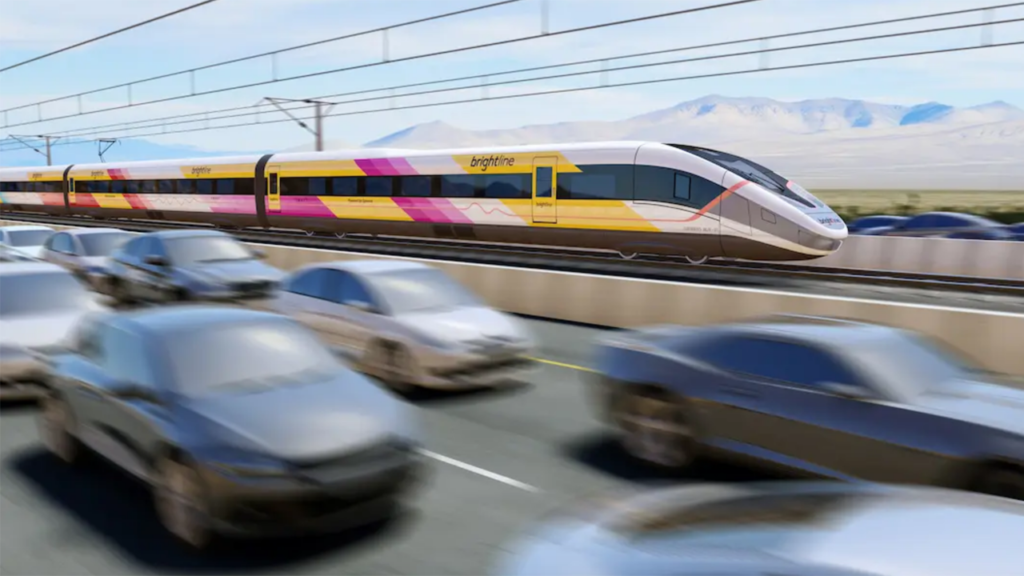
STB Advances $12B Brightline West Project
Written by Marybeth Luczak, Executive Editor
Brightline West says its planned 218-mile passenger rail service will run from Las Vegas to Rancho Cucamonga, Calif., with 96% of its alignment within the median of the I-15 highway.
The Surface Transportation Board (STB) has authorized construction and operation of a modified alignment of the high-speed passenger rail project proposed by private-sector firm Brightline West, subject to environmental mitigation measures.
STB in its Nov. 15 decision (download below) explained that in 2019, DesertXpress Enterprises, LLC, (doing business as Brightline West) “filed a petition to reopen this proceeding, seeking modification of a 2011 condition concerning the construction of an approximately 190-mile rail line for high-speed passenger rail service between Victorville, Calif., and Las Vegas, Nev. (the LV Line)” (see map above). That condition, STB said, authorized construction of a designated alignment, and DesertXpress sought authority for modifications to the previously approved alignment. Among the modifications: relocating the rail alignment on certain portions of the Line from the east side of the I-15 freeway to the median; revising the design of the Apple Valley station to include the passenger boarding and alighting platforms in the median of the I-15 freeway; and raising and moving east a portion of the existing I-15 northbound lanes to provide the necessary footprint and access for these passenger platforms.
“Environmental review of the modified route had been ongoing and was recently completed,” STB reported. “Specifically, the Board’s Office of Environmental Analysis (OEA) has worked with the Federal Railroad Administration (FRA), the lead agency on the environmental and historic review for this project under the National Environmental Policy Act (NEPA) and related environmental laws, including Section 106 of the National Historic Preservation Act (NHPA). As part of this process, OEA has reviewed a 2020 reevaluation by FRA (FRA 2020 Reevaluation) of the modified alignment, as well as a subsequent reevaluation by FRA (FRA 2023 Reevaluation) considering further route modifications proposed by DesertXpress in 2022. OEA concludes that FRA adequately assessed the potential environmental and historic impacts associated with the project modifications and concurs with FRA’s determination that a Supplemental Environmental Impact Statement (EIS) is not necessary. OEA also recommends that the Board impose the revised mitigation measures in Appendix D of the FRA 2023 Reevaluation [see STB decision]. Historic review of the project modifications had also been ongoing and was completed this year. A Programmatic Agreement (PA) setting out the final terms for compliance with Section 106 was executed on August 15, 2023.”
In sum, the STB explained that it had “already authorized construction and operation of the LV Line [between Victorville, Calif., and Las Vegas, Nev.] by exemption in 2011, and the modified alignment would lessen or avoid a number of potential environmental impacts by placing much of the routing in the I-15 median.” It noted that “the merits of a high-speed rail passenger line connecting Las Vegas and Southern California are substantial … Moreover, providing a rail alternative along the I-15 corridor would not only create a transportation benefit for passengers; it would also create environmental benefits in replacing highway vehicle traffic, and its associated emissions, with more environmentally friendly rail travel. Therefore, after considering the transportation merits, the environmental issues, and the entire record, the Board will grant the petition for exemption and authorize the modified alignment of the LV Line by modifying the 2011 routing condition, subject to compliance with the mitigation measures listed in Appendix D of the FRA 2023 Reevaluation.”
Also on Nov. 15, the STB authorized DesertXpress Enterprises, LLC, to construct and operate approximately 50 miles of new rail line between Victor Valley, Calif., and Rancho Cucamonga, Calif., subject to environmental mitigation conditions (download decision below).
According to the STB, DesertExpress Enterprises, LLC on April 13, 2021, “filed a petition under 49 U.S.C. 10502 for an exemption from the prior approval requirements of 49 U.S.C. 10901 to construct and operate an approximately 50-mile high-speed passenger rail line between the Victor Valley, in Southern California, and Rancho Cucamonga, Calif., (the RC Line)” (see map below). On July 12, 2021, the STB instituted a proceeding under 49 U.S.C. 10502, and through the OEA, participated in the environmental and historic review of the RC Line as a cooperating agency under the lead of the FRA. “This thorough environmental review took a ‘hard look’ at environmental impacts, selected a preferred alternative, and recommended environmental mitigation conditions to avoid or minimize the selected alternative’s potential environmental impacts,” the STB reported. “After considering the entire record on both the transportation and the environmental issues, the Board will grant DesertXpress’ petition for exemption, subject to environmental conditions.”

The STB, in its decision filing, explained that the RC Line’s alignment will be entirely within the I-15 right-of-way except for the final mile at Rancho Cucamonga, which will exit the I-15 right-of-way, proceed west along 8th Street and terminate adjacent to the Southern California Regional Rail Authority’s (Metrolink’s) Rancho Cucamonga train station on the south side of 8th Street west of Milliken Avenue. The Rancho Cucamonga station will link DesertXpress’ train services with the passenger services operated by Metrolink and the bus rapid transit system. “DesertXpress states that connecting its service to Metrolink’s rail system in this manner will create a seamless all-rail option for travel between Las Vegas and points throughout the greater Los Angeles, Calif., Orange County, Calif., and San Bernardino, Calif. metropolitan areas,” STB reported.
The RC Line, it said, will be built and operated on a dedicated, fully grade-separated right-of-way with no at-grade crossings; it will consist of a single main-line track with passing sidings and will be dedicated exclusively to high-speed passenger service. According to the STB, current plans are to operate 50 trains per day (25 in each direction) between Las Vegas and Rancho Cucamonga; trains will depart from both Las Vegas and Rancho Cucamonga at 45-minute intervals and will operate at speeds up to 180 miles per hour.
According to Railway Age Contributing Editor David Peter Alan, when the new line enters service, “it will fill a gap in the nation’s passenger rail network that has existed since May 1997. That was when Amtrak discontinued the Desert Wind, a train between Los Angeles and Salt Lake City that stopped at Las Vegas and connected with the California Zephyr, which still runs between Chicago and the Bay Area.”

In a related development, San Bernardino County Transportation Authority in June was awarded a $25 million RAISE (Rebuilding American Infrastructure with Sustainability and Equity) program grant from the U.S. Department of Transportation to fund the final design and construction of two intercity passenger rail stations and associated facilities in Hesperia and Victor Valley on the Brightline West high-speed rail corridor. “The High Desert stations are an integral component to our 218-mile [Las Vegas-to-Rancho Cucamonga, Calif.] system and will connect millions of residents with America’s first true high-speed rail system,” Brightline West President Sarah Watterson said at that time. “We’re moving toward a groundbreaking later this year, kickstarting one of the largest job creators in the country and setting the stage for a new era in transportation. We are appreciative of our federal partners, the SBCTA and all those who support our system.”
Further Reading: Brightline West Makes Progress



